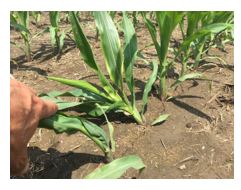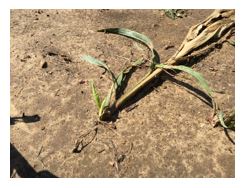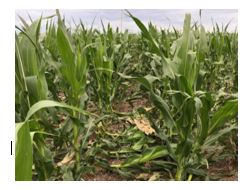It is that time of year when we hear about green snap occurring in corn. Last year, we came off a very cool April into an unusually warm May/June which caused the corn to grow very rapidly in a short time making it more vulnerable to green snap. This year, a combination of mild temperatures, plentiful moisture and topdressing of nitrogen kickstarted the corn after a very wet, cool May. Conditions like this can accelerate corn growth especially during the V5 (5 leaf) to pre-tassel vegetative growth stages which is known as the rapid growth period for corn. Rapid growing conditions is not a bad thing for corn but it can make it more susceptible to green snap. Green snap is all about timing. Wind events, hybrid susceptibility and rapid growing conditions all must occur at the same time.
What is Green snap?
Green snap, also known as brittle snap, is the breaking of corn plants during a period of rapid growth and development due to extreme wind events. Corn is most susceptible to green snap from about V5 to VT (tassel). During this time, the corn plant is rapidly generating new vegetative growth which means rapid cell division and less structural integrity. When walking corn at knee high or less, the slightest kick to a plant will snap it easily.
Factors Affecting Green Snap Severity
- Rapid growing conditions – warm, moist weather, high fertility rates especially nitrogen, high planting populations and conventional tillage (warmer soils)
- Field topography characteristics and row direction relative to wind direction
- Application of growth regulator herbicides such as 2,4-D or dicamba, especially applied late or during warm and humid conditions (Figure 1).
- Hybrid genetic differences – Genetically certain hybrids are more susceptible to green snap especially those with rapid early growth.
- Timing and severity of wind events
Figure 1
Plant twisting and leaning injury from post application of 2.4-D.

What is the Yield Impact of Green Snap Injury?
- Plants that green snap at V8 stage or less will typically regrow with 2 tillers (Figure 2). These tillers will not produce a normal ear, but often will produce a tassel ear which usually gets infected with corn smut and is not harvestable.
- Plants that green snap at larger than V8 up to VT tend to break right below where the ear will develop. These plants will not have yield potential for grain and become a non-productive weed using available nutrients and water (Figure 3).
- Sometimes plants can green snap above the ear during early grain fill (R1 – Blister). Since over half the carbohydrate to fill the ear come from the top half of the plant, ears on these plants can range from no yield if snap occurs just after pollination (Figure 4) or to only about half the potential if the snap occurs during mid grain fill.
- Obviously, yield impact varies with the severity and timing of the breakage. Fields with less than 10% damage will have very little impact on yield because the surrounding plants will compensate for the stand loss with larger ears, benefitting from both more sunlight and nutrients.
Figure 2
Green snap @ V6 stage. Note two tillers regenerating near the base of the corn plant.

Figure 3
Green snap @ V12 stage. Stalk breakage located below ear zone.

Figure 4
Green snap @ R1 stage. Note ear failed to set grain despite stalk breakage above the ear.

Managing the Risk of Green Snap Injury
- Plant more than one hybrid or maturity. Hybrids that differ in their genetic makeup and maturity have different windows of green snap susceptibility. Planting a package of diverse hybrids spreads out the risk of injury.
- Use caution when post-applying growth regulator type herbicides. These herbicides can temporarily make the stalk more brittle after application which can increase the potential for green snap injury. Dicamba-based chemistry is the preferred option over 2,4-D chemistry due to less brittleness and twisting on the plant. In addition, avoid applying these types of herbicides to corn when the weather forecast indicates severe storm potential within the next 3 days.
- Consider crop insurance coverage for wind damage for more susceptible fields.

